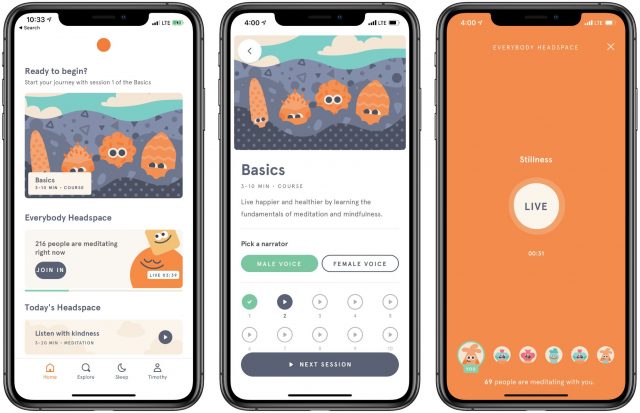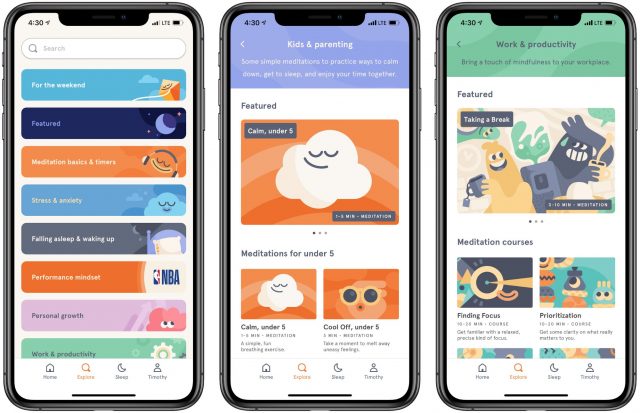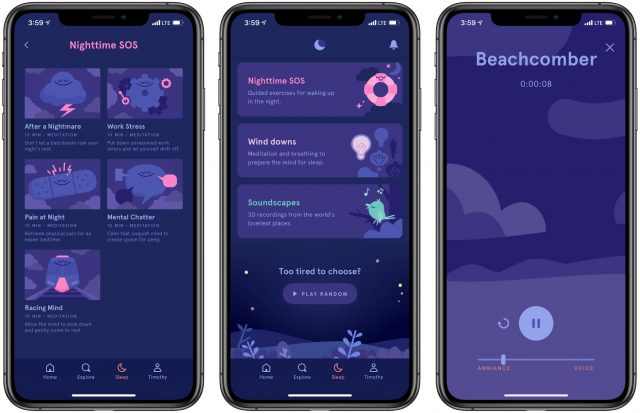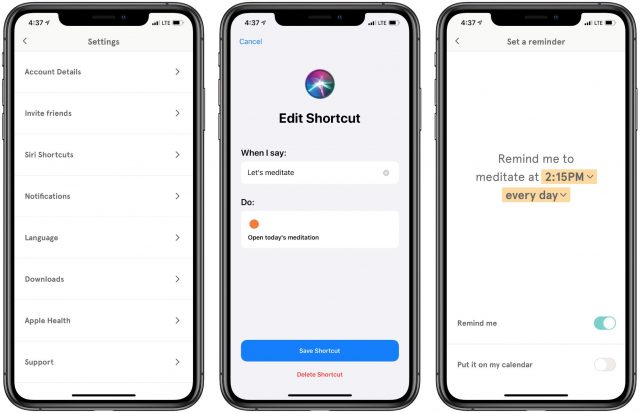Headspace: A Guided Meditation Companion
Cultures across the globe have practiced meditation in various forms for centuries. But despite its prevalence, meditation feels daunting to many. Headspace brings powerful, easy-to-follow, guided meditation to the masses through its iOS, Android, and Web apps.
In recent years, scientists have associated meditation with a wide variety of benefits ranging from improvements in memory, digestion, and circulation to reductions in stress, loneliness, and cognitive decline. Headspace has a team of scientific researchers that has published 16 studies in peer-reviewed journals about the benefits of guided meditation for focus, kindness, happiness, stress relief, and more.
I have found meditation to be profoundly beneficial for regaining focus when my mind wants to wander, falling asleep when my thoughts won’t stop, and alleviating stress and anxiety when life gets difficult.
At its core, Headspace is a content subscription service. The iOS app (which I use), Android app, and Web app are important for the quality of experience you receive, but the real value is in the company’s content—audio recordings of guided meditations.
Getting Started with Headspace
The Headspace Basics course is a good place to start for anyone who hasn’t spent much time meditating. It provides ten guided meditations. When starting each installment, you can select a 3-, 5-, or 10-minute version and pick between a male or female guide. Each installment begins with a short lesson about meditation concepts and then transitions into the guided meditation.
Once you’ve completed the Basics course, or if you’re already comfortable with the foundational concepts of mindfulness meditation, try out Headspace’s everyday meditations. These are good for users who want to create a consistent meditation practice.
If you find the idea of meditating with other people appealing, Headspace provides an option called Everybody Headspace, which offers guided meditations that begin at regular times throughout the day and night. You can either wait with others for the next session or join an ongoing session.

Exploring Headspace Content
The Explore tab organizes Headspace’s content by type, so it’s great when you want a meditation for a specific situation. For reference, the English catalog in the iOS app is organized into the following sections:
- Featured
- Meditation basics and timers
- Stress and anxiety
- Falling asleep and waking up
- Performance mindset
- Personal growth
- Work and productivity
- Kids and parenting
- Life challenges
- Sports
- Physical health
- Day to day exercises
- Students
- Helpful tips and support
Headspace content is available in three languages: English, German, and French. I don’t speak German or French, but I did switch the app to those languages and looked through the content. The libraries in those languages appear to be a bit smaller than the English library but are still substantial. There also appear to be differences in content between the mobile apps and the Web app, the latter of which feels like an afterthought in this regard.

Using Headspace to Improve Sleep
The Sleep tab of Headspace offers more than just guided meditations. It has five types of sleep-themed content:
- Sleepcasts: 45-minute stories told with ambient sounds playing behind them. I found the stories a bit distracting, but I like that once you begin playing a sleepcast, Headspace provides a slider to make the voice or the background sounds more prominent.
- Sleep Music: Tracks of soothing music to help you fall asleep
- Nighttime SOS: Guided meditations to help you get back to sleep when you’ve woken up in the middle of the night
- Wind downs: Meditations and breathing exercises to help you get ready to sleep
- Soundscapes: Soothing recordings of real-world sounds like a lakeside campfire, a tropical night, or a laundromat
Headspace includes a Play Random button at the bottom of the sleep page for those times when you’re too tired to choose.

Using Headspace in iOS
Headspace is a good iOS citizen. It’s updated regularly (26 times in the last 5 months) and includes support for a bunch of iOS-specific features.
For example, Headspace integrates with Apple’s Health app. With that feature turned on in Headspace settings, any meditation you complete in the app will be saved as Mindful Minutes in the Health app. That’s the same metric that the Breathe app on the Apple Watch uses.
Headspace also supports Shortcuts to some extent. I’d like to see this feature expanded in the future, but it currently lets you create shortcuts to start your daily meditation and to help you fall asleep with that night’s meditation.
Headspace for iOS app also offers four different types of notifications:
- Mindfulness moments: Enable this option to receive between one and five different messages throughout the day to remind you to be mindful.
- Recommendations: If you don’t have a habit of meditating, turn these on to get Headspace to recommend when to meditate and which meditation to do.
- Meditation reminders: Set a reminder to meditate at a specific time every day, on weekends, or on weekdays. You can also have Headspace block out that time on your default calendar.
- Bedtime reminders: You set these reminders separately. The wind-down reminder alerts you to do a wind-down meditation before bed, and the bedtime reminder lets you know when it’s time for bed.

Subscribing to Headspace
You can access a small set of Headspace’s content for free in iOS and Android, or on the Web. I strongly recommend this trial content if you’re new to meditation and unsure how much you’ll use Headspace.
If you find Headspace helpful, after you’ve outgrown the free library, you can subscribe to Headspace for $12.99 per month when paid monthly or $7.99 per month when paid yearly ($95.98). Headspace also offers a family plan that allows up to six accounts for $19.99 per month. If you’re a student, you can get Headspace for the steep discount of $9.99 per year. Headspace is also available for businesses, some of which (like my employer) offer Headspace for free as a health perk.
Headspace is priced based on its potential to improve your life. If you’re not making a habit out of using Headspace for meditation or not finding it impactful, stick with Headspace’s free content or try a free alternative like Oak (which is great but doesn’t have nearly as much content). But if, like me, you do find Headspace’s particular mix of guided meditation content and app design useful and impactful, it’s worth the cost.
I’ve been using TenPercent Happier meditation app for 2 1/2 years. It’s phenomenal. I have not tried Headspace so cannot compare them. I like the idea of a family plan tho I think Ten Percent is cheaper than Headspace. I like that some of the country’s leading meditation teachers present the courses and stand-alone meditations in Ten Percent. Whatever helps people develop mindfulness, focus, stress relief, control of difficult emotions, relationships, sleep, awareness of self and others, pain relief is all positive. The more who do it, the better and healthier the planet.
I’m also using 10% Happier, and very much for the same reasons as you, Jackie.
Previously I had looked at Calm, Insight Timer, and also Headspace, but 10% Happier is my favorite so far: its approach is very down-to-earth, solidly presents the science behind meditation, and has zero esoteric overtones. Oh, and it also does not try to be cute.
I’m with you on this, @dohlink.
There are a bunch of good apps out there as well as meetups in most cities for group guided meditation. Use whatever works for you!
10% Happier seems to be getting a lot of love from App Store promotion recently too. I’ll have to check it out. (I’ve tried a bunch of others but not that one.)
I actually like that Headspace tries to be cute haha. I completely get why you wouldn’t, but I find the little illustrations fun.
I’ve been quite happy with Insight Timer for 3 years. The meditations are contributed by teachers from around the world and include music, guided, beginners’ “tutorials”, and meditation courses.
The free version is excellent but you can also opt for the $5/month subscription which adds playback options and downloading tracks for offline listening. One can also submit comments to the tracks and send messages to other meditators around the world.
Thanks for sharing, @apta.
It’s cool to find TidBITS readers that enjoy meditation apps and to know that there are a bunch of good options for iOS.
I love using the Synctuition meditation program. I have started using it every evening after my workout as part of my relaxation routine and I gotta say that, once you get used to it, it is simply mind-blowing. At first it was a bit weird, as the binaural beats and gamma waves really give your brain a workout and, like any muscle, it takes time to get it working to its full potential. Now I wake up feeling more rested than ever before and my energy and happiness levels have skyrocketed. I am amazed at how quickly Synctuition became a habit I can’t do without. The 25 minutes I spend listening to it every day leave me feeling like I can take on the world!
Hi Timothy,
you mention in your TidBITS article that Headspace comes in English, Dutch and French. As a native Dutch speaker, this surprised me, so I went to have a look. It turns out that it is in English, Deutsch and Français, and ‘Deutsch’ means ‘German’ in German… I don’t know why the English language refers to the language that is spoken in the low countries as Dutch (and not as Netherlandish or Hollandish), but it surely is a source of confusion…
It’s fixed now. Thanks for the heads up!
After reading the article I checked the wikipedia page for Headspace
It struck me as, once again, people monetizing mental wellbeing; for my parents’s generation it was usually a church telling you what to think (or providing sermons for you to contemplate).
In the 1960s Transcendental Meditation™ was very popular by way of American Culture exploiting it’s marketability, aimed at younger adults…
I’m happy if some people find this stuff beneficial and don’t end up getting fleeced.
I AM surprised that TidBITS would give it space (and a platform). AND I can’t help wondering if some of the positive reviews are posted by bots…
Good luck,
Ron
I fail to see the problem with a company providing a (legal) service for a fee, whatever the field. No one is being forced to subscribe, and if Headspace’s particular approach helps someone in a real way, that seems like a good thing.
As far as positive reviews being posted by bots, I’m not sure what venue you’re thinking about, but I’m confident there are no bots posting comments here. Aside from Discourse’s automated bot prevention techniques, I read each and every post on this site, and am familiar with most of the people. I think I’d notice if bots started posting. (And in fact, there have been a handful of spammers who have registered accounts and then posted here in the last few years; I’ve banned them and deleted their messages as soon as I realized.)
It’s good to know you delete bots and spammers, Adam.
My wife is a clinical social worker who specialized in PTSD, victims of trauma (esp. domestic violence, sexual abuse and child abuse. She has promoted meditation and mindfulness for years, as I (a Christian pastor). Much of this work has been done through many different faith traditions for centuries. There is much that is available out there and if a company is providing the latest clinical resources and it provides people better health options and healing then those looking at the company should welcome the option - it is up to them to decide if that is a good option. I, for one, am very grateful to TidBITS for offering the information and their view of the item. I happen to use a program called Pray as you go (at APP store) which I find very helpful. Deeply appreciate all the previous comments, which, if TidBITS had not offered the original post I might not have known about - and am copying comments to send to people in our fields as additional information. So, I sort of disagree with your concern but also think you offer a good point about the financial end of the program. Thanks.
I also meant to include that I too work with victims of violence and difficult life circumstance, including traumatic grief. Thank you all for your input because it will be used to help others!
As a psychiatrist treating many anxiety disorders, it is nice to be aware what different modalities are available and that included apps. Many studies have been done that show that Computer Assisted Therapy (CAT) can be as beneficial as a human therapist and easier for some people. If it helps them, then they should use it. Mindfulness therapy techniques have been used for years but are only recently becoming more popular, but they are very useful for many people. As long as privacy issues are addressed in these treatments, I am OK with them.
Every psychologist and psychiatrist is “monetizing mental wellbeing,” and every doctor is “monetizing physical wellbeing.” I find it remarkable that that concept could be reason for concern for some.
While apps like Headspace will never replace human mental-health experts, they both share the same scientific underpinnings from sound meditation research. And unlike other “offerings” that, sadly, do exploit their customers’ gullibility — such as psychic readings, “energy healing,” and similar non-scientific nonsense — these apps support a meaningful meditiation practice for their users, and do so at a relatively modest subscription fee.
Why, then, should TidBITS not feature these kinds of applications?
Thanks for the input, @jochen. That’s encouraging.
Headspace is an app that has been beneficial in my life, and my hope in writing about it was to help anyone else who happened to be interested.
Because entries on Wikipedia are not always vetted or updated, I did some quick search which turned up quite a lot of recent research from very respected sources that came to the conclusion that meditation, as well as meditation combined with yoga, does help adults suffering with PSTD and hypertension. Here are just five examples:
Impact of Transcendental Meditation on Psychotropic Medication Use Among Active Duty Military Service Members With Anxiety and PTSD
https://www.ncbi.nlm.nih.gov/pubmed/26741477
Mindfulness meditation may ease anxiety, mental stress
https://www.health.harvard.edu/blog/mindfulness-meditation-may-ease-anxiety-mental-stress-201401086967
Meditation and Yoga for Post Traumatic Stress Disorder: A Meta-Analytic Review of Randomized Controlled Trials:
https://www.ncbi.nlm.nih.gov/pmc/articles/PMC5939561/
Meditation Helpful In Reducing Blood Pressure:
https://www.kent.edu/research/meditation-effective-reducing-blood-pressure
Benefits of mindfulness meditation in reducing blood pressure and stress in patients with arterial hypertension
https://www.ncbi.nlm.nih.gov/pubmed/30425326
News Flash - healthcare is not free, including mental healthcare. In Britain and other countries with universal health care, taxes pay for it. Though I am not religious, I do know many good and kind people who are. And many religious leaders, like Martin Luther King, have been greatly beneficial to society.
Around 1970, A young hippie college drop out, Steve Jobs, followed in the footsteps of Transcendental Meditation devotees he admired, The Beatles, Rolling Stones, Donovan, Mia Farrow and others and travelled to India to study spirituality and meditation with a different guru, Neem Karoli Baba, who happened to consider apples the perfect fruit and had a habit of tossing them around. Though the guru died just before Steve arrived, Steve did spend considerable time and studied extensively at the ashram. Mark Zuckerberg, who considers Steve Jobs his mentor, began studying there on Steve’s recommendation when Facebook was getting off the ground. Zuckerberg recently returned from another of his many visits to the ashram, which has since become a sort of Mecca for tech leaders from companies including Google:
https://www.washingtonpost.com/world/asia_pacific/inside-the-indian-temple-that-draws-americas-tech-titans/2015/10/30/03b646d8-7cb9-11e5-bfb6-65300a5ff562_story.html
https://www.independent.co.uk/news/world/asia/kainchi-dham-the-indian-ashram-where-silicon-valley-s-finest-go-to-discover-themselves-a6720006.html
I’ve been a TidBITS Talker since the day Adam started the list, and I’ve always been glad TidBITS covers a wide variety of Apple related subjects, including meditation. And Adam does an outstanding job of vetting every article and post.
Another meditation app (free) hat has been very helpful to me is Smiling Mind from an Australian not-for-profit of the same name (www.smilingmind.com.au). As long as non-Australians don’t mind the accent .
.
I know Americans who would be interested BECAUSE of the accent haha. Thanks for sharing!
Since this app deals in the realm of psychology, here’s a quotation from psychologist Carl Jung: “…the relatively unconscious man is driven by his natural impulses because, imprisoned in his familiar world, he clings to the commonplace, the obvious, the probable, the collectively valid, using for his motto: ‘Thinking is difficult. Therefore, let the herd pronounce judgement.’” (1959)
I just heard on the news that Headspace is offering free, especially created “New York State Of Mind” mindfulness sessions to New York State residents. I am certainly going to take advantage of this generous offer: